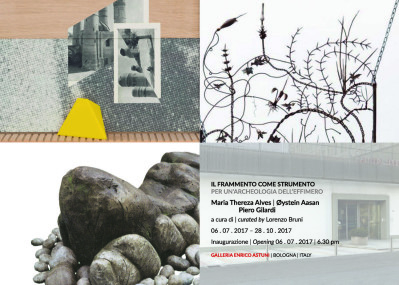
Exhibitions

Maria Thereza Alves – Øystein Aasan e Piero Gilardi
Bologna, Galleria Enrico Astuni
from 06.07.2017 to 28.10.2017
Curated by: Lorenzo Bruni
Press release: PDF
From 6.30 p.m., on 6 July 2017, the Galleria Astuni will be presenting a show curated by Lorenzo Bruni titled “IL FRAMMENTO COME STRUMENTO. Per un’archeologia dell’effimero” with the internationally known artists Maria Thereza Alves, Øystein Aasan, and the special participation of Piero Gilardi, an artist active in the sphere of Arte Povera and an anticipator of Relational and Interactive Art.
The group show “IL FRAMMENTO COME STRUMENTO. Per un’archeologia dell’effimero”, curated by Lorenzo Bruni, is characterised by large-scale “environmental installations” by Maria Thereza Alves (São Paulo, 1961; she lives and works in Berlin and Naples) and Øystein Aasan (Norway, 1977; he lives and works in Berlin). Both inquire into the idea of monuments and their new possible function by proposing a dialogical and contextual environment. In one part of the gallery rises a structure/volume by the Brazilian artist that makes us think about the tension between the idea of culture, that of nature, and colonialism. The artist establishes this narrative by bringing together archival documents, handwritten notes, and illustrations of the plants considered to be “typical” of the Guangzhou area, which she studied on the occasion of the 2008 Triennial. On the other side of the exhibition room is placed, instead, the structure/platform conceived of by the artist from Northern Europe; he is someone who inquires into the health of the modernist heredity, and the connections between architecture, rites, and the concept of the sublime. Aasan manages this by developing a dialogue/friction between paintings and sculptures, found images and objects that have been created or recreated.
The works on show have in common the wish to adopt remains and fragments in order to arrive at a totality through which they aim to question themselves, from an anomalous viewpoint, about the possible role of art objects today. The associations that these artists establish with their images/documents evoke a wider narrative through which they make the observers reflect, not so much on the identity of a civilisation from the past, but on the one of which they are a part. Such a “potential” kind of narration, one that is activated live and in which the presence of the observers is fundamental, is not the point of arrival but, rather, of the departure of a cognitive process and not just a formal expression. In this way the artists can stimulate interesting discussions both about which knowledge, of a Western kind, it is possible to hand on now in a period of digital archives, and about the search for a new relationship between the observed object and the observer in the “expanded present” of the social media. Their aim is to establish an open dialogue dealing with contemporaneity, with the specific culture through which people interpret reality and, above all, about the search for a new kind of morality when looking at things/information.
The special participation of Piero Gilardi (Turin, 1942; he lives and works in Turin) allows the show to supply further stimuli about the themes dealt with, also thanks to the 2001 interactive sculpture titled “Scoglio Bretone”, as well as other interventions by him that derive from his wish to characterise exhibition spaces in a “transcendental” manner. These latter works further underline the need to shift the argument being dealt with away from the point of view of reporting to one that is extremely ontological. Gilardi has always worked on the transformation of cultural references in contrast to those of nature, an approach that has allowed him to create an “other” communication with respect to that promoted by the mass media. This approach has led him to think in a direct way about the question of what it means to be active and/or activists in a computerised society, a theme that today really needs further inquiries.










